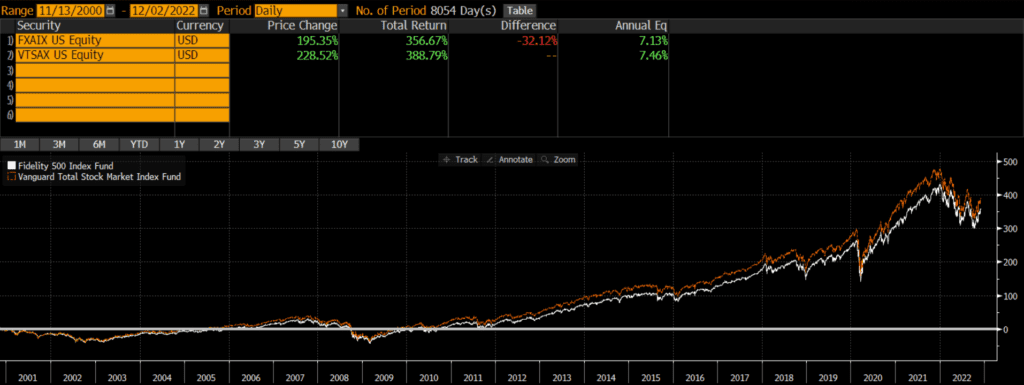The Fidelity S&P 500 Index Fund (FXAIX) and the Vanguard Total Stock Market Index fund (VTSAX) are two of the largest mutual funds in existence and easily two of the most popular among individual investors. FXAIX and VTSAX are the core of many investor portfolios and many investors compare FXAIX vs VTSAX in order to decide which should be the foundation of their portfolio.
The Short Answer
The main difference between FXAIX and VTSAX is that FXAIX is a large- and mid-cap ETF, while VTSAX is a total market mutual fund. Despite these differences, the total return between these two funds is nearly identical and I consider them interchangeable for all intents and purposes.
A quick reminder that this site does NOT provide investment recommendations.
The Long Answer
Historical Performance: FXAIX vs VTSAX
FXAIX was launched on February 17, 1988, while VTSAX was launched on November 13, 2000. Since then VTSAX has outperformed by roughly .33% annually. This is most likely driven by small-caps’ relative outperformance initially, even though that trend has reversed during the past decade. Despite variations in the size factor performance over the decades, the long-term performance between these two funds is incredibly similar.

Differences between FXAIX vs VTSAX
The biggest difference between FXAIX and VTSAX is the market cap exposure of the funds. FXAIX tracks the S&P 500 index which includes mostly large-caps and some mid-caps, while VTSAX covers much more of the market by including more mid-caps and small-caps.
Geographic Exposure
Both FXAIX and VTSAX hold essentially 100% stocks, so I will not dig into country exposures or market classification here. For intents and purposes, the two funds have identical exposures.
Market Cap Exposure
FXAIX focuses on the S&P 500 index and so it mostly holds large-caps with a bit of mid-cap exposure. VTSAX tracks the broader CRSP US Total Market Index and so it owns many more mid-caps and small-caps, as of 11/30/2022. In other words, FXAIX is a large-cap vehicle, while VTSAX is a total market vehicle. That being said, due to market cap weighting, both funds are overwhelmingly influenced by the large-cap holdings.
| FXAIX | VTSAX | |
| Large-Cap | 84% | 73% |
| Mid-Cap | 16% | 19% |
| Small-Cap | 0% | 9% |
Sector Weights
The sector weights between FXAIX and VTSAX are nearly identical, as of 11/20/2022. The weights are within 1% for every single sector.
| FXAIX | VTSAX | |
| Basic Materials | 2.27% | 2.51% |
| Consumer Cyclical | 10.59% | 10.66% |
| Financial Services | 13.60% | 13.79% |
| Real Estate | 2.75% | 3.45% |
| Communication Services | 7.36% | 6.80% |
| Energy | 5.37% | 5.31% |
| Industrials | 8.69% | 9.64% |
| Technology | 23.60% | 23.06% |
| Consumer Defensive | 7.39% | 6.75% |
| Healthcare | 15.42% | 15.17% |
| Utilities | 2.96% | 2.87% |
Final Thoughts: FXAIX vs VTSAX
Both FXAIX and VTSAX are large, core funds sponsored and managed by Fidelity and Vanguard respectively. Although FXAIX is more of a large-cap ETF and VTSAX is a total market mutual fund, performance has been nearly identical. I view these two funds as essentially interchangeable and would not spend too much energy trying to decide which one is “better.”
However, there are some situations that may call for one fund versus another. For instance, many custodians offer free ETF trades, but charge trading fees or redemption fees for mutual funds. So I might select FXAIX or VTSAX solely based on where my account is held. Despite these considerations, these two funds are very similar for all intents and purposes.